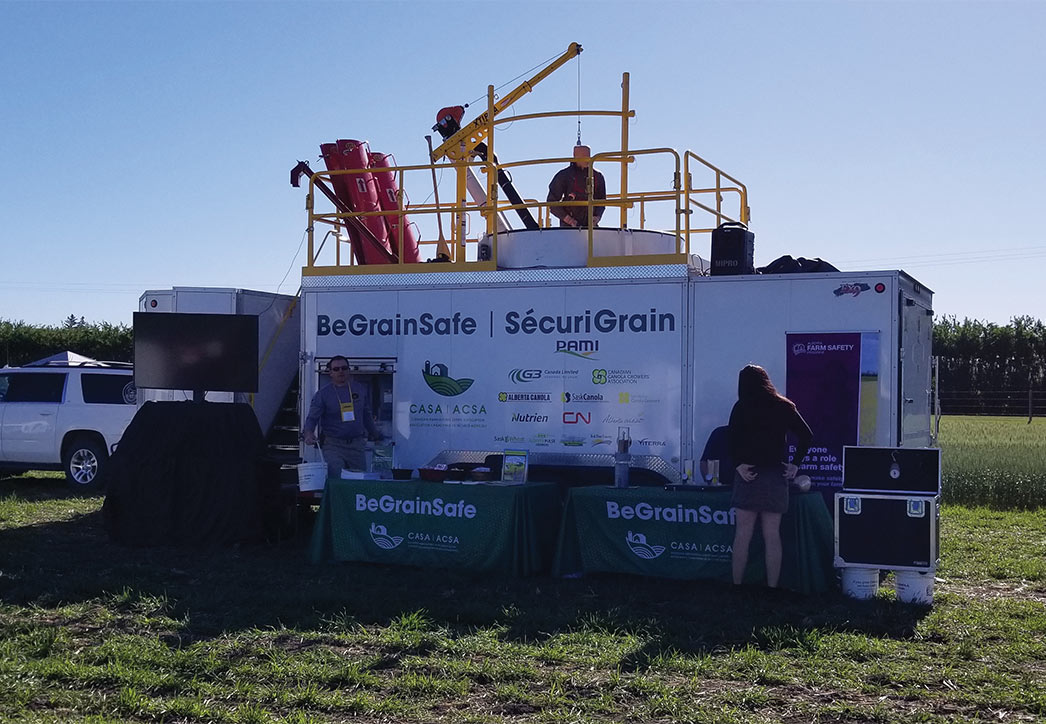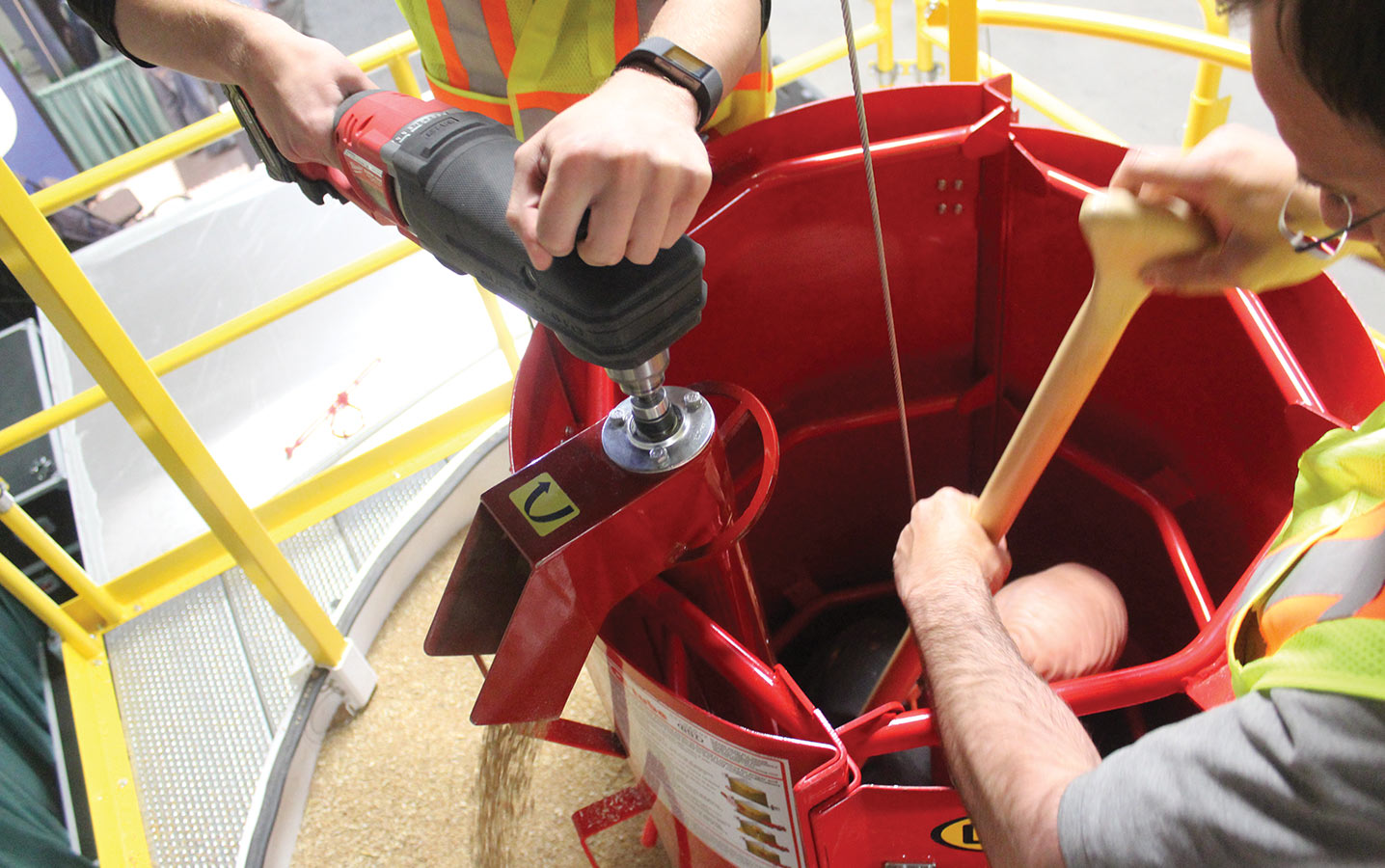BeGrainSafe: Tips for safe grain handling
When Gerry Hertz was 23, his father was killed instantly when an auger he and Hertz’s brother-in-law were pulling across the yard made contact with an electrical line. The brother-in-law survived, but still lives with the repercussions.
“Probably every farmer out there has a story that could have turned out differently,” says Hertz, a Saskatchewan farmer and SaskCanola board director.
Although accidents can still happen even when you take steps to mitigate them, Hertz believes many accidents occur because of inattentiveness or a lack of planning.
The Canadian Agricultural Safety Association (CASA) helps with safety planning to make agriculture a safe and healthy environment to work and live. CASA launched its grain safety program, BeGrainSafe, with awareness-raising displays and demonstrations at farm shows, firefighter training and producer education.
“The BeGrainSafe Program is the first of its kind in Canada,” says Robert Gobeil, CASA’s agricultural health and safety specialist. “With large yields, increased grain handling capacity and the reports of deaths and injuries due to grain, CASA and its partners recognized the need for a program to help with education and awareness.”
CASA works with leaders in the ag industry, including Canadian Canola Growers Association, SaskCanola, Alberta Canola and Manitoba Canola Growers. “These sponsors and partners have been vital in getting the BeGrainSafe message and education to firefighters, farmers and the general public,” says Gobeil.

Trapped in grain prevention and rescue
Standing atop flowing grain can quickly turn to tragedy. The grain can act like quicksand, pulling its victim down and burying a person in only seconds. While people can usually avoid standing in the backs of trucks or bins as they’re being filled or unloaded, moving grain that has spoiled and bridged can create a dangerous scenario.
Preventing a scenario that could lead to entrapment by an avalanche of spoiled grain or collapse of a grain bridge may be as easy as maintaining good grain condition.
“Keeping grain in good condition is the very first step in preventing grain entrapment,” says Gobeil. “Develop storage strategies, monitor moisture and temperature, try to maintain adequate aeration and follow recommendations for storage times.”
The area Hertz lives in allows him to normally harvest his crop dry, but he’s cognizant of not putting wet grain in a bin and he uses aeration to condition grain as needed for safe storage.
Safety in and on bins
Falls are the third leading cause of agriculture-related injuries, and it only takes two seconds to fall 64 feet, CASA reports.
The most obvious culprit is using a ladder improperly. Besides choosing the right ladder for the right job, CASA urges farmers to safeguard against dirty and wet rungs, and defects like broken rungs, loose bolts and split rails. And before flying up those rungs, first place the ladder on solid and level ground and, if necessary, use boards under the ladder’s feet to make it stable and level.
Even better would be to avoid climbing bins in the first place, especially during the rush of harvest. Keep bin hatch ropes in good working order and use bin-full sensors on the bins or the auger. If farmers can arrange for their tasks to be performed from the ground or using a scissor lift or cherry picker, so much the better.
Fires in the field
Fires only need oxygen, a heat source and material to ignite. Dry harvest fields have lots of material that can burn. It just takes a heat source to ignite that material.
Something as simple as arranging for a parking spot can stop a fire from breaking out. “When parking a truck with a low muffler in a field, get the combine operator to cut the crop three inches high for 50 to 100 feet so there’s a place you can park and not create a fire,” says Hertz.
CASA also urges farmers take measures to avoid fires during refuelling. Before gassing up, CASA recommends turning off the engine and letting the machine cool down for five minutes.
When fuelling, avoid using electronic devices like mobile phones or MP3 players as a spark could cause ignition, CASA adds.
And before starting back up, clean up minor spills and allow any spilled fuel on the engine to evaporate first. And of course ensure a fire extinguisher is present.
Combine fires
Anybody owning a Lamborghini would take care to make sure nothing ever happened to their baby, yet every year we see combines – many of them worth more than a Lamborghini – engulfed in flames. Taking time to clean away chaff and dust can prevent some of these combine fires.
Some crops are more prone to excess buildup on a combine, making it necessary for inspections and cleaning to occur more often.
A few key areas to inspect and clean include batteries, feeder area, engine compartment, rotor covers, ground drive transmission, chopper area, tailings housing, frame ledges and wire harness. Using a leaf blower or compressed air in a fire-safe area (including fields) can make cleaning much easier.
“Safety is an investment of time, says Gobeil. “Simply taking the time to clean key areas of the combine can prevent a costly fire.”





